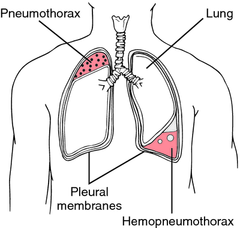Hemopneumothorax Definition, Symptms, Causes, Treatment
When a fracture of the rib breaks through the lungs, the blood of the affected lung also accumulates in the pleural space this is called hemopneumothorax because the pleural space contains both blood and air. The amount of blood that accumulates in the pleural space depends on the size and extent of lung damage. In some cases, the accumulation of blood is minimal in other cases, it is significant. As blood and air continue to accumulate in the pleural space, the pressure on the lungs shrinks through the mediastinum to the healthy lung.
A pneumothorax is a hemopneumothorax with bleeding in the pleural space. This is usually due to a penetrating trauma, such as a shot or a knife. Initial trauma allows air to enter pleural space and create pneumothorax. Bleeding caused by trauma allows the blood to collect in the pleural space with air, creating hemopneumothorax.
Bleeding may originate from damaged blood vessels, pulmonary bruising, or even rapid deceleration. History and physical results of hemopneumothorax are similar to hemothorax, including dyspnoea, tachypnea and tachycardia. Patients can also obviously represent chest trauma, possibly hypotension and shock. Physical exploration can reveal possible segments of ulcers, subcutaneous emphysema or hematoma. Lung exudation reveals reduced or absent breathing sounds of affected lungs and hyperresonance on percussion.
Some commonly reported symptoms of pneumothorax are given below
A pneumothorax is a hemopneumothorax with bleeding in the pleural space. This is usually due to a penetrating trauma, such as a shot or a knife. Initial trauma allows air to enter pleural space and create pneumothorax. Bleeding caused by trauma allows the blood to collect in the pleural space with air, creating hemopneumothorax.
Bleeding may originate from damaged blood vessels, pulmonary bruising, or even rapid deceleration. History and physical results of hemopneumothorax are similar to hemothorax, including dyspnoea, tachypnea and tachycardia. Patients can also obviously represent chest trauma, possibly hypotension and shock. Physical exploration can reveal possible segments of ulcers, subcutaneous emphysema or hematoma. Lung exudation reveals reduced or absent breathing sounds of affected lungs and hyperresonance on percussion.
Hemopneumothorax Symtoms
Some commonly reported symptoms of pneumothorax are given below
- Chest Pain
- Shortness of breath
- Tachypnea
- Tachycardia
- Hypoxia
- Decreased breath sounds
- Subcutaneous Emphysema
- Palipitation
- Feeling of Heavy chest
Hemopneumothorax Causes
Exact underlying cause of hemopneumothorax can only be done via radiological findings. However, some injuries that have strong correlation with hemopneumothorax are blunt chest taruma, penetrating chest injury, fractured ribs and aspiration of hemothorax. Important radiological findings during scanning are obliteration of costophrenic angle, fluid level with air shadow above, collapsed lung border.
Hemopneumothorax Treatment
Treatment of hemopneumothorax mainly depends on invasive procedure. Patient having severe form of hemopenumothorax should be decompressed via chest tube before starting any procedure. In case of tension penumothorax emergent needle decompression with large gauge needle placed in the second intercostal space at midclavicular line. To minimize chances of infection you health care provider may prescribe you antibiotics as well.
Hemopneumothorax Definition, Symptms, Causes, Treatment
 Reviewed by Simon Albert
on
September 06, 2019
Rating:
Reviewed by Simon Albert
on
September 06, 2019
Rating:
 Reviewed by Simon Albert
on
September 06, 2019
Rating:
Reviewed by Simon Albert
on
September 06, 2019
Rating:












